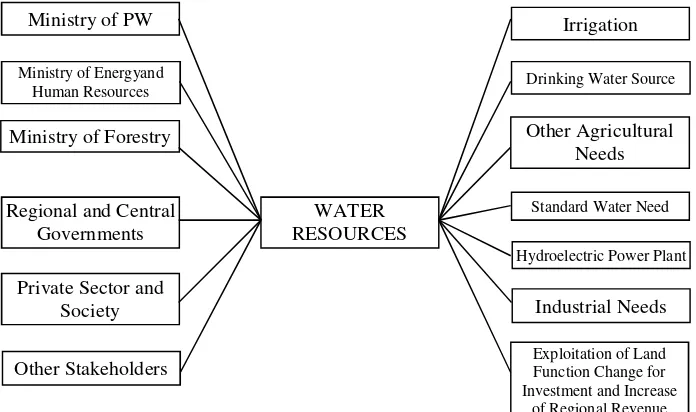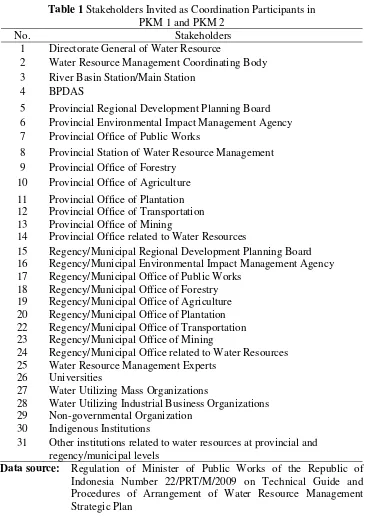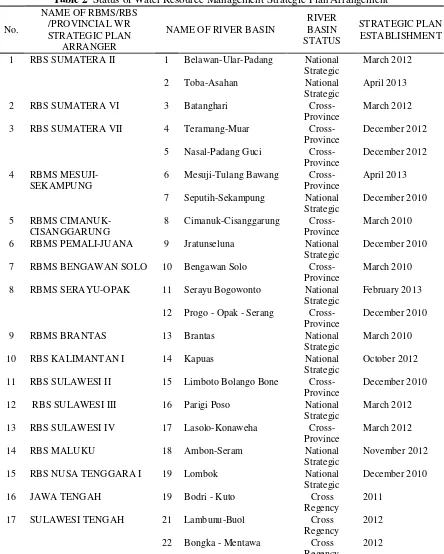THE MEANING OF COORDINATION IN
THE ARRANGEMENT OF WATER RESOURCE MANAGEMENT
STRATEGIC PLAN IN INDONESIA
Irwan Syafri
Researcher on Experimental Station for River ResearchCenter for Water Resources
Ministry of Public Works
Jl. Solo-Kartosuro km7 Pabelan, Surakarta 57101 Phone.: (0271) 719429, Facs.: (0271) 716406
Abstract
Several activities related to water resource management of a river basin are conducted by several institutions, each of which tends to do it in sectorial scope to implement their duties and functions. They even contradict to each other. Consequently, the water resource management of a river basin becomes a very complex matter. In order to make all parties related to water resource management work collaboratively and synergetically in accordance to their duties and functions, the strategic plan of water resource management is arranged. The arrangement is conducted by integrating and adjusting the interests of several sectors, regions, and stakeholders. The formal coordinating forum in arranging the strategic plan is Community Consultation Meeting 1 andCommunity Consultation Meeting 2.The coordination of the arrangement of water resource management strategic plan is categorized as interrelated horizontal coordination. Therefore, the effectiveness of the coordination depends on the reciprocal respect, loyalty, and coordinator competence.
Keywords:stakeholders, river basin,water resource management, strategic plan, integration, coordination
INTRODUCTION
Indonesia is an archipelagic nation consisting of 17,508 islands with 6,000 among which are inhabited. The
Indonesian islands are spread along one-eighth of the equator, namely 8 million km2, with the total area of
1.92 million km2. The width of Indonesian sea is 3 million km2, with the total length of coastal areas of
around 84,000 km.
In 2013, the Indonesian population reaches 250 millions, with the growth rate 1.66%, so in 2020 the population is predicted to be 280 millions. The densest island is Java with the population 58% of Indonesian total population, while the width of the island is only 6.58% of the total area of Indonesia.
In general, Indonesia has abundant water resource. It is recently recorded that the potential reserve of Indonesian water resource reaches ± 3,906 billion m3/year spreading around the nation through 8,007 river basins and 521 lakes, with reliable volume to be utilized ± 690 milyar m3/year. However, the water resource potentials inIndonesia are not evenly distributed, observed both from the geographical location of each island and from the precipitation distribution rate. The surface water resources decrease during dry season, but during the rainy season, some areas suffer from flood. The national average of precipitation rate is more than 2,500 mm/year, however, there is large difference in some particular areas. Nusa Tenggara, Maluku and Sulawesi are the arid areas with the precipitation rate less than 1,000 mm/year. Some districts in Papua, Jawa, and Sumatra are very wet areas with the precipitation rate more than 5,000 mm/tahun.
Policy on Water Resource Management
The policy on water resource management is the strategic guidance in water resource management which consists of the stages containing indicative programs to realize the vision and mission in the water resource management. The vision of the water resource management is “National Water Resources are Comprehensively and Integratedly Managed and Environmentally Sound for the Justice and Prosperity of all Indonesian People”, referring to the seven foundations of the management as stipulated in Law Number 7 of 2004 on Water Resources, those are: preservation, balance, public utility, integration and harmony, justice, independence, transparency and accountability. To realize that vision, the national policy on water resource management in the next 20 (twenty years) will be implemented through five missions, namely 1) To increase the water resource conservation continuously; 2) To utilize the water resources for the justice and prosperity of the society; 3) To control and reduce the water destructive force; 4) To increase the society and business world participation in water resource management; and 5) To build an integrated national water resource information system among sectors and regions.
The policy on water resource management is arranged and formulated by the board of water resource. The board of water resource is a coordinating body of water resource management. The policy of water resource management at the national level is arranged and formulated by the national board of water resource appointed by the president. The policy of water resource management at the provincial level is arranged and formulated by the provincial board of water resource or using other name and appointed by the governor. The policy of water resource management at the regent/municipal level is arranged and formulated by the regent/municipal board of water resource or using other name appointed by the head of regency/head of municipal region.
River Basin
River basin is a united area of water resource management in one or more Catchment Areaand/or small islands with the width less than or equal with 2,000 km2. The number of river basins in Indonesia based on the Regulation of Minister of Public Works Number: 11A/PRT/M/2006 was 133. Based on the Decree of President of the Republic of Indonesia Number 12 of 2012 on Decision on River Basin, the number of river basins in Indonesia has been revised to 131 with the calculation as follows: 5 cross-country river basins, 29 cross-province river basins, 29 nationally strategic river basins, 53 cross-regency/municipal area river basins, and 15 regent/municipal river basins.
Moreover, based on the Regulation of Minister of Public Works No: 26/PRT/M/2006,30 River Basin
Organization (RBO) have been established. The institutions are the management institutions of water resources of river basins, which are juridically under the central government. In the development, their number reaches 33RBOs. There are also other 57 RBOs established which work together with and under the provincial governments.
Water Resource Management Strategic Plan
Water resource management strategic plan is a basic framework in designing, implementing, monitoring, and evaluating the activities of water resource conservation, water resource utilization, and water destructive force control in every river basin based on the principle of integration between surface water and ground water.
Water resource management strategic plan includes at least objectives and basic considerations of water resource management, scenario of future water basin condition, water resource management strategies, and operational policy to implement the water resource management strategies. Water resource management strategic plan is determined based on the design of water resource management strategic plan. The design of water resource management strategic plan is formulated for 20 (twenty) year time period. The established water resource management strategic plan can be reviewed and evaluated at least every 5 (five) years. The result of the review and evaluation becomes the basic consideration for the perfection of the water resource management strategic plan.
DISCUSSION
The Complexity of Water Resource Management
can be located in a regency/municipal area, cross-province area, or cross-country area. The availability of water resources in each Catchment Area is highly influenced by the local weather and hydrogeological conditions which result in the existence of one Catchment Area with abundant water availability and another one with water shortage. The Catchment Area with the water shortage needs to be supplied with the water from neighboring wetter Catchment Area, thus, the inhabitants of the dry Catchment Area have the equal opportunity to grow. The integration of several Catchment Areas into one water resource management area has introduced the terms river basin which is further used as the area basis of water resource management. However, the development of water resource management of river basin turns to be more difficult because there are several activities related to water resource management conducted by several institutions. To implement their duties and functions, those institutions tend to work in sectoral scope. Each institution follows the authority, policy, and funding scheme of its founding ministry/institution. They have different priorities of interests which often contradict to each other. Each institution also has different approach both in the planning stage and in the implementation stage. Hence, the water resource management of a river basin can be said as a very complex matter considered from the number of parties involved and related to the problem of cross-sector and cross area.
Figure 1Complexity of Water Resource Management
Therefore, in order that all parties related to water resource management can play their roles collaboratively and sinergetically based on their duties and functions, a document is arranged as a guidance or direction in designing programs and activities between sectors and between administration areas. The document is water resource management strategic plan. Consequently, a coordinating body, namely Water Resource Management Coordinating Team (TKPSDA) of river basin, which funtions to formulate and arrange the water resource management strategic plan of river basin, is established. The membership of TKPSDA of river basin consists of the governmental and non-governmental elements in an equal number based on representativeness. TKPSDA of river basin functions to receive, absorb, and channel all stakeholders’ aspirations and complaints.
The Stages of Water Resource Management Strategic Plan Arrangement
Based on the Regulation of Minister of Public Works Number Nomor 22/Prt/M/2009 on Technical Guides and Procedures of the Arrangement of Water Resource Management Strategic Plan, the stages of the arrangement of water resource management strategic plan of river basin in general include the stages of preparation, composition, andestablishment. The activities conducted in the preparation stage are studying the policy on the water resource management, inventorying data, identifying environment conditions and the problem, and conducting Society Consultation Meeting (PKM) 1. (PKM) 1is conducted to get inputs, responses, and corrections from the stakeholders, especially on the general conditions of water resources of river basin. The activities conducted during the stage of strategic plan composition are revising the problem formulation and the possibility of water resource potential development, formulating the river basin
Ministry of PW
Ministry of Energyand Human Resources
Ministry of Forestry
Regional and Central Governments
Private Sector and Society
Other Stakeholders
WATER RESOURCES
Irrigation
Drinking Water Source
Other Agricultural Needs
Standard Water Need
Hydroelectric Power Plant
Industrial Needs
Exploitation of Land Function Change for Investment and Increase
condition scenario, analyzing some basic considerations in deciding the direction of the water resource management, constructing some alternative strategies for each scenario to reach the goal of water resource management and operational policy concepts, and conducting Society Consultation Meeting (PKM) 2.(PKM) 2 is conducted to get inputs, responses, and corrections from the stakeholders, especially on the river basin condition scenario to further conduct the revision on the design of the water resource management strategic plan. Next, the revised design of the water resource management strategic plan is submitted to the minister, governor, or regency/municipal head in accordance to their authorities on the established river basin management
Coordination
Etymologically, “coordination” means things related to organizing an organization or activity so that the regulation and activity that will be implemented will not contradict to each other or be inordered. In management terms, coordination means a process to integrate the objectives and activities to separated units (departments or functional units) in an organization to reach the goal efficiently and effectively. Coordination can be divided into two types, namely vertical coordination and horizontal coordination. Vertical coordination is the activities of unification and briefing by the superior to the acting units and the working units under his authority and responsibility. In vertical coordination, the superior coordinates all apparatus under his direct responsibility. Horizontal coordination is to coordinate actions or activities of unification and briefing for the activities at the equal oraganizational level. This horizontal coordination is divided into interdisciplinary andinterrelated. Interdisciplinaryis a coordination to direct, unite the actions, realize, and build discipline among units both internally and externally in the units with the same tasks.
Interrelatedis inter-institution coordination or with other units with different functions, but each unit depends on one another or it has internal or external relation with another unit at equal level.
The coordination in the arrangement of water resource management strategic plan aims at integrating and harmonizing the interest of various sectors, areas, and stakeholders in the field of water resource of river basin. Formal coordination forum in arranging the strategic plan is Society Consultation Meeting (PKM) 1 and Society Consultation Meeting (PKM) 2. The objects coordinated in the Society Consultation Meeting (PKM) 1 are the general conditions of water resource of a river basin, consisting of the inventory result of environmental conditions, the identification result of environmental conditions, the water resource potential, the current water resource problems, and the future potential problems of water resource. The objects coordinated in the Society Consultation Meeting (PKM) 2 are the scenario of river basin conditions, the alternative strategy options, and the operational policy concept of water resource management. Since in one river basin there are many parties involved with their own interests, authorities, tasks, and responsibilities which are different from one another, the coordination cannot be controlled by one command line. Therefore, the developed coordination is based on the functional relation through integration approach. Among the involved parties, there must be principles of trust, openness, responsibility, and reciprocal need to grow. Hence, in the implementation of integrating and harmonizing the interests of many sectors, areas, and stakeholders, there is a clear picture of authority and responsibility of each party (who, doing what, when, where, and how)
(business entity), industry utilizing water, Regional Drinking Water Company, Hydroelectric Power Project, water transportation, tourism, fishery, and other more. The key stakeholders are the stakeholders that own legal authority in decision making, such as executive and legislative elements. Some examples of
the elements are central government and regional government related to water resource management, Balai
Besar Wilayah Sungai (River Basin Main Station), Balai Wilayah Sungai (River Basin Station), and Dinas Pengelolaan Sumber Daya Air (Water Resource Management Office).
Table 1 Stakeholders Invited as Coordination Participants in PKM 1 and PKM 2
No. Stakeholders
1 Directorate General of Water Resource
2 Water Resource Management Coordinating Body
3 River Basin Station/Main Station
4 BPDAS
5 Provincial Regional Development Planning Board
6 Provincial Environmental Impact Management Agency
7 Provincial Office of Public Works
8 Provincial Station of Water Resource Management
9 Provincial Office of Forestry
10 Provincial Office of Agriculture
11 Provincial Office of Plantation
12 Provincial Office of Transportation
13 Provincial Office of Mining
14 Provincial Office related to Water Resources
15 Regency/Municipal Regional Development Planning Board
16 Regency/Municipal Environmental Impact Management Agency
17 Regency/Municipal Office of Public Works
18 Regency/Municipal Office of Forestry
19 Regency/Municipal Office of Agriculture
20 Regency/Municipal Office of Plantation
22 Regency/Municipal Office of Transportation
23 Regency/Municipal Office of Mining
24 Regency/Municipal Office related to Water Resources
25 Water Resource Management Experts
26 Universities
27 Water Utilizing Mass Organizations
28 Water Utilizing Industrial Business Organizations
29 Non-governmental Organization
30 Indigenous Institutions
31 Other institutions related to water resources at provincial and
regency/municipal levels
Data source: Regulation of Minister of Public Works of the Republic of Indonesia Number 22/PRT/M/2009 on Technical Guide and Procedures of Arrangement of Water Resource Management Strategic Plan
Table 2 Status of Water Resource Management Strategic Plan Arrangement
1 RBS SUMATERA II 1 Belawan-Ular-Padang National Strategic
3 RBS SUMATERA VII 4 Teramang-Muar
Cross-Province
6 RBMS PEMALI-JUANA 9 Jratunseluna National Strategic
December 2010
7 RBMS BENGAWAN SOLO 10 Bengawan Solo Cross-Province
March 2010
8 RBMS SERAYU-OPAK 11 Serayu Bogowonto National Strategic
11 RBS SULAWESI II 15 Limboto Bolango Bone Cross-Province
December 2010
12 RBS SULAWESI III 16 Parigi Poso National Strategic
March 2012
13 RBS SULAWESI IV 17 Lasolo-Konaweha Cross-Province
17 SULAWESI TENGAH 21 Lambunu-Buol Cross
Regency
2012
22 Bongka - Mentawa Cross
Regency
2012
Data source: Sub-Directorate of River Basin Planning, Directorate for Water Resources Management, Directorate General of Water Resource, Ministry of Public Works
CONCLUSION
Formal coordination forum in the arrangement of water resource management strategic plan is Society Consultation Meeting 1 and Society Consultation Meeting 2.
The objects coordinated in the arrangement of water resource management strategic plan are the inventory result of environmental conditions, the identification result of environmental conditions, the water resource potential, the current water resource problems, the future potential problems of water resource, the scenario of river basin conditions, the alternative strategy options and operational policy concept of water resource management.
The coordination implementer of the arrangement of water resource management strategic plan is Coordinating Team of Water Resource Management (TKPSDA) of river basin together with all stakeholders.
The aim of coordination in the arrangement of water resource management strategic plan is integrating and harmonizing the interests of various sectors, areas, and stakeholders in the field of water resource of river basin.
The effectiveness of coordination of the arrangement of water resource management strategic plan highly depends on the reciprocal respect to each party’s authority, loyalty, and coordinator competence.
ACKNOWLEDGEMENT
I would like to extend my gratitude to Experimental Station for River, which has given facilities for me to complete this paper.
REFERENCES
Anshori, I. 2010. Konsepsi Pengelolaan Sumber Daya Air Menyeluruh dan Terpadu.www.dsdan.go.id.
Deputy of Cabinet Secretary of Law. 2008.Peraturan Presiden Republik Indonesia Nomor 12 Tahun 2008
Tentang Dewan Sumber Daya Air. Jakarta: Deputy of Cabinet Secretary of Law
Minister of Public Works of the Republic of Indonesia.2009.Peraturan Menteri Pekerjaan Umum Nomor
22/Prt/M/2009 Tentang Pedoman Teknis Dan Tatacara Penyusunan Pola Pengelolaan Sumber Daya Air.
Minister of Public Works of the Republic of Indonesia.2013.Peraturan Menteri Pekerjaan Umum Republik
Indonesia Nomor 02/Prt/M/2013 Tentang Pedoman Penyusunan Rencana Pengelolaan Sumber Daya Air.
Minister of Law and Human Rights of the Republic of Indonesia. 2008. Peraturan Pemerintah Republik
Indonesia Nomor 42 Tahun 2008 Tentang Pengelolaan Sumber Daya Air. State Gazette of the Republic of Indonesia Number 82 of 2008. Jakarta
Minister of Public Works of the Republic of Indonesia. 2008. Peraturan Menteri Pekerjaan Umum Nomor
04 /PRT/M/2008 Tentang Pedoman Pembentukan Wadah Koordinasi Pengelolaan Sumber Daya Air Pada Tingkat Provinsi, Kabupaten/Kota, dan Wilayah Sungai.
StateSecretary of the Republic of Indonesia. 2004. Undang-Undang Republik Indonesia Nomor 7 Tahun
2004 Tentang Sumber Daya Air,State Gazette of the Republic of Indonesia Number 32 of 2004. Jakarta: State Secretariat.
Handoko, T.H. 2003.Manajemen,2nd ed. Yogyakarta.


